翻译技巧2 Converting
- 格式:ppt
- 大小:720.50 KB
- 文档页数:14
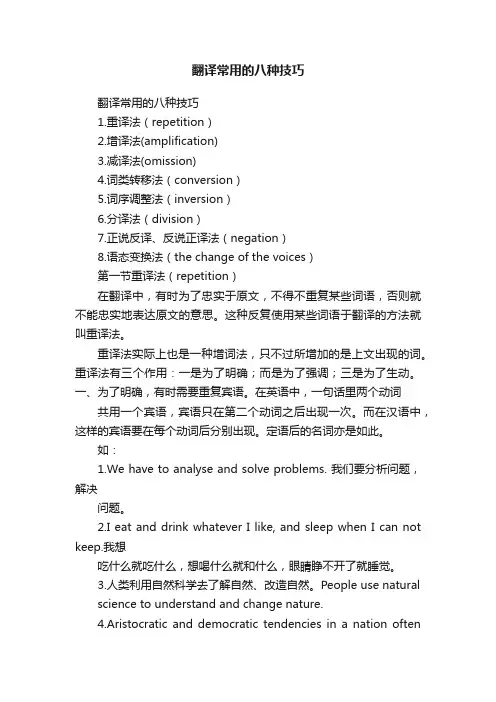
翻译常用的八种技巧翻译常用的八种技巧1.重译法(repetition)2.增译法(amplification)3.减译法(omission)4.词类转移法(conversion)5.词序调整法(inversion)6.分译法(division)7.正说反译、反说正译法(negation)8.语态变换法(the change of the voices)第一节重译法(repetition)在翻译中,有时为了忠实于原文,不得不重复某些词语,否则就不能忠实地表达原文的意思。
这种反复使用某些词语于翻译的方法就叫重译法。
重译法实际上也是一种增词法,只不过所增加的是上文出现的词。
重译法有三个作用:一是为了明确;而是为了强调;三是为了生动。
一、为了明确,有时需要重复宾语。
在英语中,一句话里两个动词共用一个宾语,宾语只在第二个动词之后出现一次。
而在汉语中,这样的宾语要在每个动词后分别出现。
定语后的名词亦是如此。
如:1.We have to analyse and solve problems. 我们要分析问题,解决问题。
2.I eat and drink whatever I like, and sleep when I can not keep.我想吃什么就吃什么,想喝什么就和什么,眼睛睁不开了就睡觉。
3.人类利用自然科学去了解自然、改造自然。
People use naturalscience to understand and change nature.4.Aristocratic and democratic tendencies in a nation oftenshowthemselves in its speech.民族的贵族倾向和民族倾向常在其言语中表现出来。
5.我们来修改安全规则和卫生规则吧。
Let’s revise our safety andsanitary regulations.二、英语常用省略,但为了明确,也为了强调某些内容,在汉语中常常要将省去的部分重译出来。
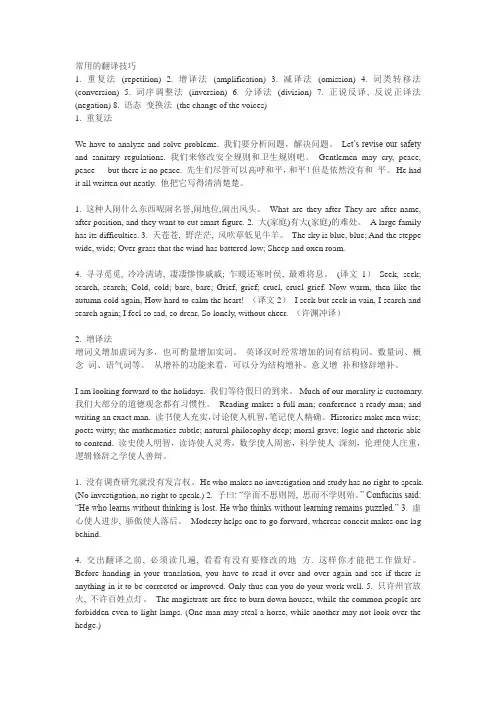
常用的翻译技巧1. 重复法(repetition)2. 增译法(amplification)3. 减译法(omission)4. 词类转移法(conversion)5. 词序调整法(inversion)6. 分译法(division)7. 正说反译, 反说正译法(negation)8. 语态变换法(the change of the voices)1. 重复法We have to analyze and solve problems. 我们要分析问题,解决问题。
Le t’s revise our safety and sanitary regulations. 我们来修改安全规则和卫生规则吧。
Gentlemen may cry, peace, peace --- but there is no peace. 先生们尽管可以高呼和平,和平!但是依然没有和平。
He had it all written out neatly. 他把它写得清清楚楚。
1. 这种人闹什么东西呢闹名誉,闹地位,闹出风头。
What are they after They are after name, after position, and they want to cut smart figure.2. 大(家庭)有大(家庭)的难处。
A large family has its difficulties.3. 天苍苍, 野茫茫, 风吹草低见牛羊。
The sky is blue, blue; And the steppe wide, wide; Over grass that the wind has battered low; Sheep and oxen roam.4. 寻寻觅觅, 冷冷清请, 凄凄惨惨戚戚; 乍暖还寒时侯, 最难将息。
(译文1)Seek, seek; search, search; Cold, cold; bare, bare; Grief, grief; cruel, cruel grief. Now warm, then like the autumn cold again, How hard to calm the heart! (译文2)I seek but seek in vain, I search and search again; I feel so sad, so drear, So lonely, without cheer. (许渊冲译)2. 增译法增词义增加虚词为多,也可酌量增加实词。
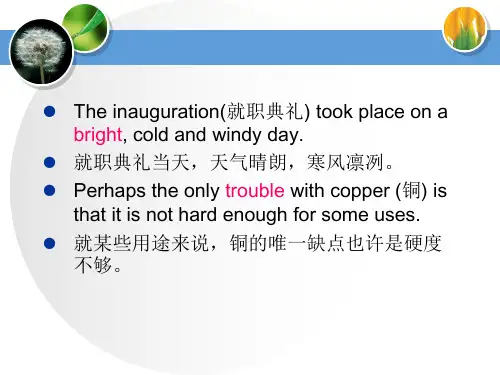
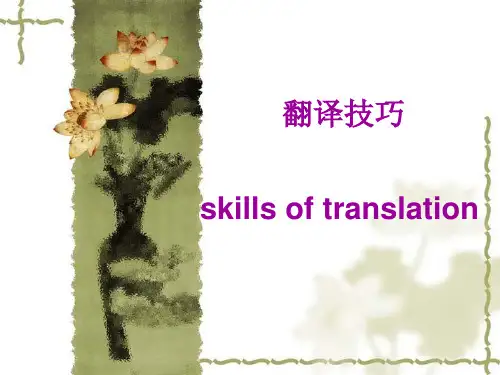
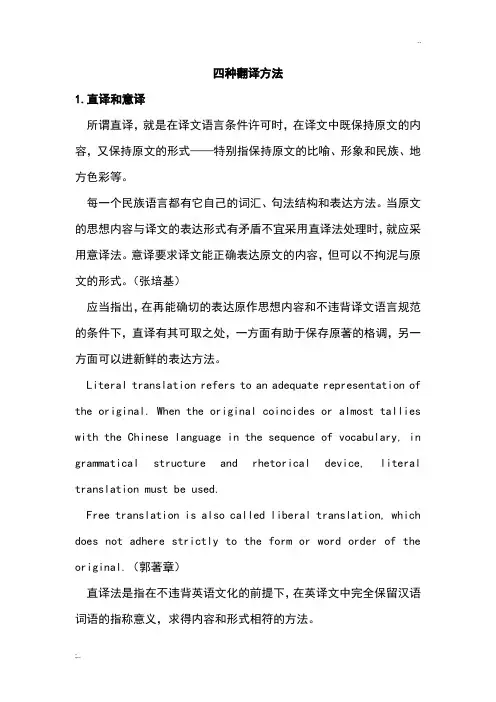
四种翻译方法1.直译和意译所谓直译,就是在译文语言条件许可时,在译文中既保持原文的内容,又保持原文的形式——特别指保持原文的比喻、形象和民族、地方色彩等。
每一个民族语言都有它自己的词汇、句法结构和表达方法。
当原文的思想内容与译文的表达形式有矛盾不宜采用直译法处理时,就应采用意译法。
意译要求译文能正确表达原文的内容,但可以不拘泥与原文的形式。
(张培基)应当指出,在再能确切的表达原作思想内容和不违背译文语言规范的条件下,直译有其可取之处,一方面有助于保存原著的格调,另一方面可以进新鲜的表达方法。
Literal translation refers to an adequate representation of the original. When the original coincides or almost tallies with the Chinese language in the sequence of vocabulary, in grammatical structure and rhetorical device, literal translation must be used.Free translation is also called liberal translation, which does not adhere strictly to the form or word order of the original.(郭著章)直译法是指在不违背英语文化的前提下,在英译文中完全保留汉语词语的指称意义,求得内容和形式相符的方法。
意译是指译者在受到译语社会文化差异的局限时,不得不舍弃原文的字面意义,以求疑问与原文的内容相符和主要语言功能的相似。
(陈宏薇)简单地说,直译指在译文中采用原作的的表达方法,句子结构与原句相似,但也不排除在短语层次进行某些调整。
意译指在译文中舍弃原作的表达方法,另觅同意等效的表达方法,或指对原作的句子结构进行较大的变化或调整。
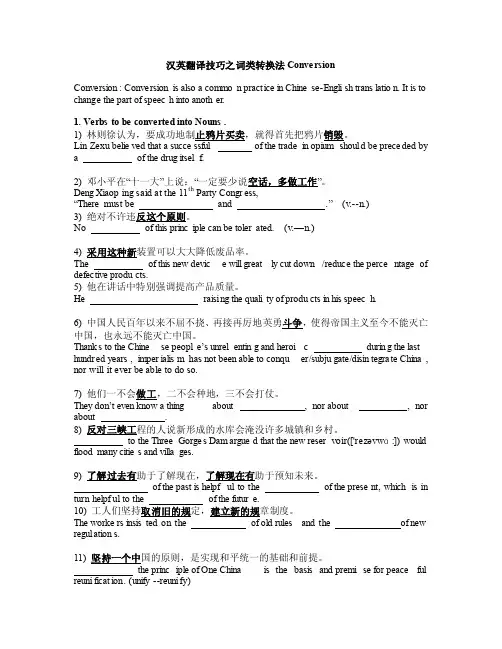
汉英翻译技巧之词类转换法 Conver sionConver sion: Conver sionis also a common practi ce in Chines e-Englis h transl ation. It is to change the part of speech into anothe r.1. Verbsto be conver ted into Nouns.1) 林则徐认为,要成功地制止鸦片买卖,就得首先把鸦片销毁。
Lin Zexu believ ed that a succes sful of the tradein opiumshould be preced ed bya of the drug itself.2) 邓小平在―十一大‖上说:―一定要少说空话,多做工作‖。
Deng Xiaopi ng said at the 11th PartyCongre ss,―Theremust be and .‖(v.--n.)3) 绝对不许违反这个原则。
No of this princi ple can be tolera ted. (v.—n.)4)采用这种新装置可以大大降低废品率。
The of this new device will greatl y cut down/reduce the percen tageof defect ive produc ts.5) 他在讲话中特别强调提高产品质量。
He raisin g the qualit y of produc ts in his speech.6) 中国人民百年以来不屈不挠、再接再厉地英勇斗争,使得帝国主义至今不能灭亡中国,也永远不能灭亡中国。
Thanks to the Chines e people’sunrele nting and heroic during the last hundre d years,imperi alism has not been able to conque r/subjug ate/disint egrat e China, nor will it ever be able to do so.7) 他们一不会做工,二不会种地,三不会打仗。
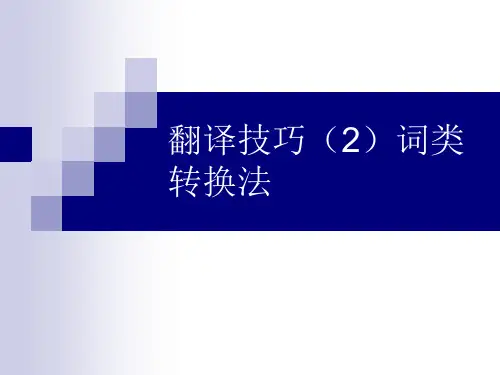
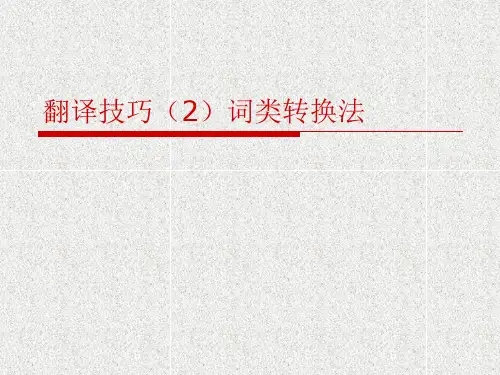
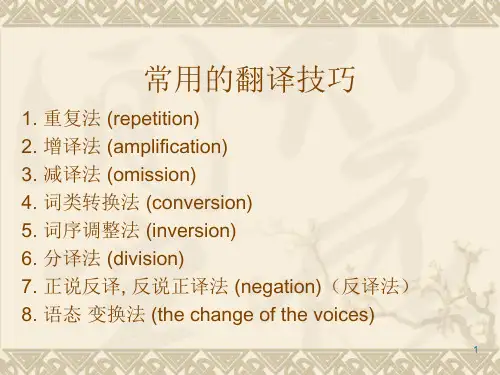
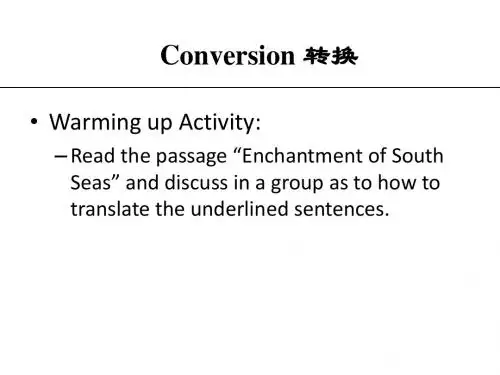
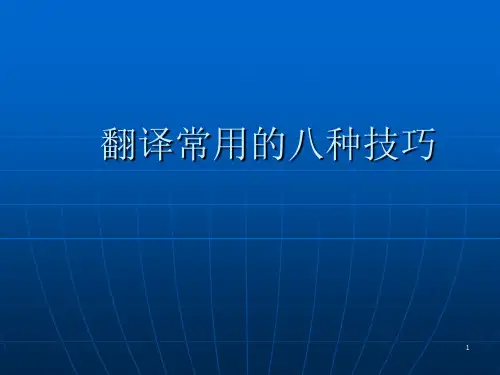
汉译英实用技巧初探提要:汉英结构和表达方式相去甚远,为了在译文中不露刀斧之痕,译者务必灵活运用转换、省译、扩译等主要实用技巧。
关键词:转换,扩译,省译一、转换技巧(transforming)由于汉英结构不同,表达方式迥异,“硬性翻译”不仅读起来别扭,而且会闹出笑话。
这就译者在翻译时灵活使用转换的技巧,有时将汉语中的动词转换成英语的介词短语,有时将并列句译成主从句,等等。
法无定法,随机而化。
力求做到云过无声,水过无痕。
读来自然流利,移植的有如原生的。
1.词类的转换(1) 名词译成动词美国反对的理由是,北朝鲜不是联合国会员。
The U.S. objected that North Korea was not a member of the UN.你很有鉴别力。
You know what‟s what.(2) 动词译成名词消防队员连续奋战了九个昼夜,才控制住了火势。
The firemen battled against the flames for nine days and nights before getting them under control.邱吉尔来到华盛顿说服罗斯福把在欧洲开辟第二战场的日期拖延下去。
Churchill arrived in Washington to talk Roosevelt out of an early invasion of Europe.富兰克林深信,我们必须学会了解我们所在的这半球的邻居并学会与他们和睦相处。
Franklin had a deep conviction that we must learn to understand and to get on with our neighbors in this hemisphere.(3) 动词译成形容词先生曰:“狼负我,狼负我!”狼曰:“吾非固欲负汝。
天生汝辈,固需吾辈食也。
”“ You are an ungrateful beast,” complained the man.“Not at all,” retorted the wolf, “it is not that I‟m ungrateful, but you men were created for us to devour.”(颜惠庆译《马中锡·中山狼传》)他急切地想得到消息。